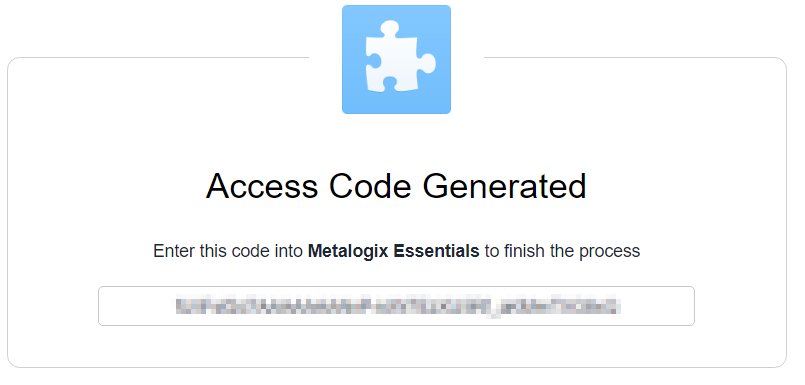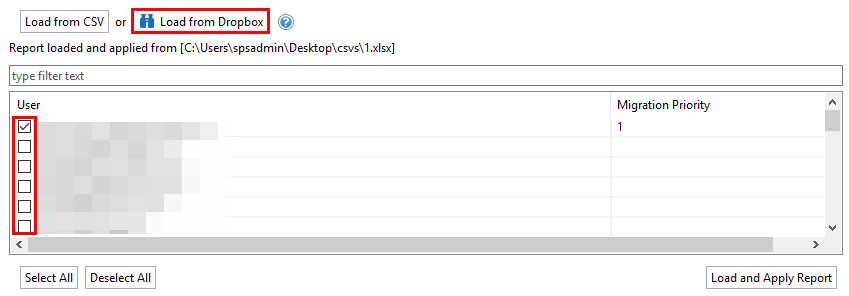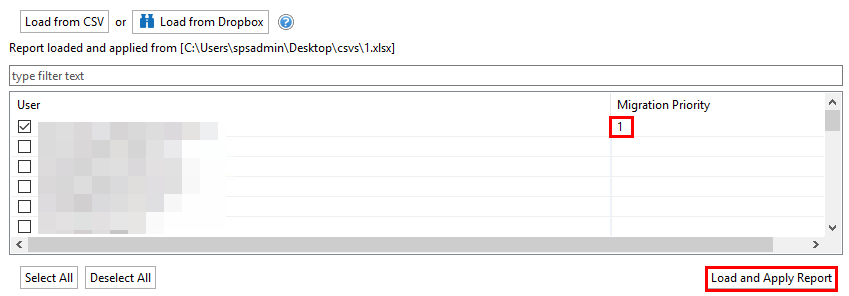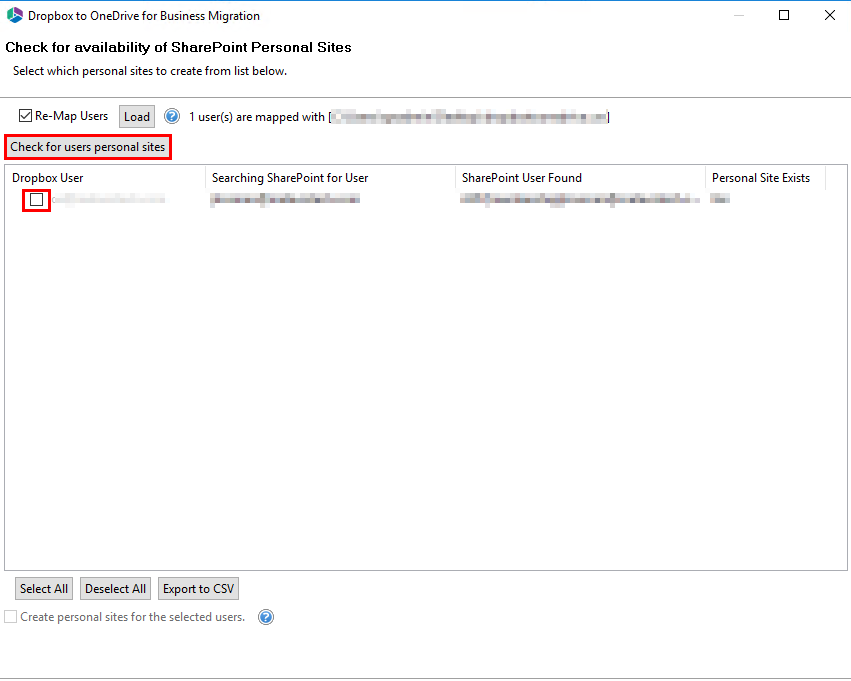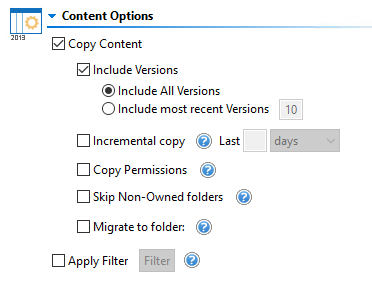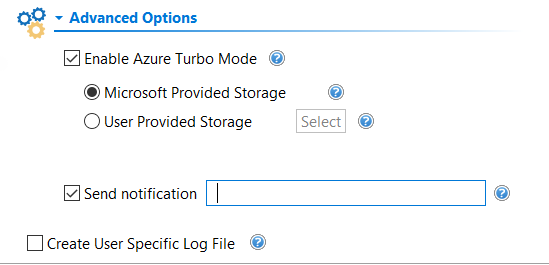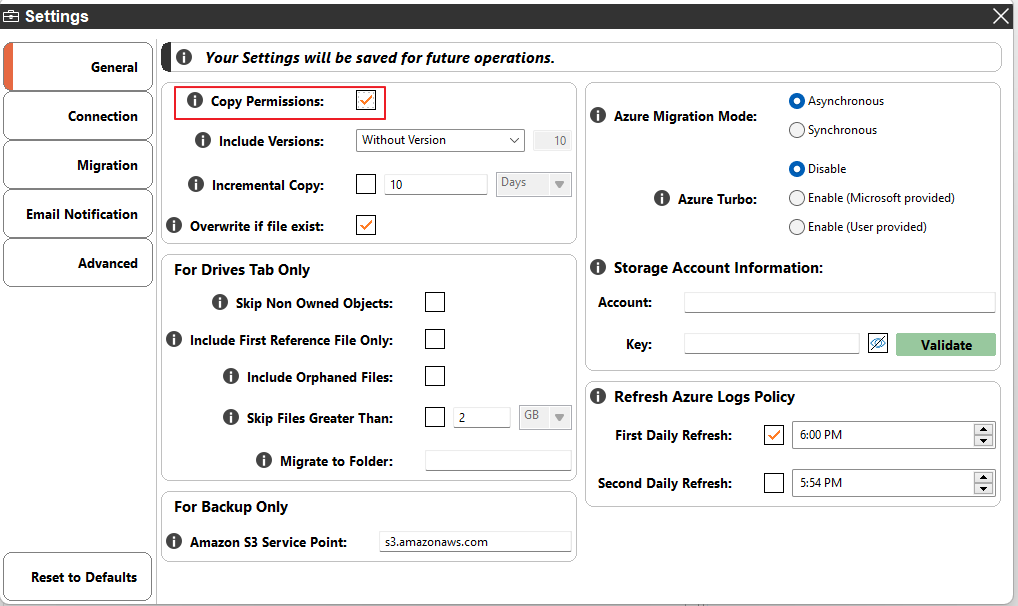Copy Dropbox
Metalogix Essentials for Drives provides a simplified, wizard driven experience to migrating content in, out, or between various drive management systems (local or cloud based). It can also provide additional functionality to managing some or all OneDrive for Business sites within a specific Office 365 tenant.
Copy Dropbox Business to OneDrive for Business
This option allows Dropbox Business and Office 365 administrators to copy content from within multiple Dropbox Business drives to their respective OneDrive for Business sites in a single migration.
|
|
NOTE: If you attempt to connect or open a Dropbox drive through the software and it does not respond, please review the section Alternate Framework. |
This operation has the following requirements for use:
·The account used to perform the migration from Dropbox Business needs to have Team Admin access to the Dropbox Business tenant.
·The account used to perform the migration into OneDrive for Business needs to be a Global Administrator or SharePoint Administrator Role in this Office 365 tenant.
·The person performing the migration will need to know the relationship (user mapping) between each user's Dropbox user account and their corresponding Office 365 user account.
·Each user account must have either a SharePoint or OneDrive license assigned to it in Office 365 and can not be in 'Blocked' status.
Once the requirements above are satisfied, you can proceed with your Dropbox Business to OneDrive for Business migration.
1.Switch to the Drives tab and click the Copy Dropbox button, then select "Copy Dropbox to OneDrive".
2.Give your project a name.
3.Enter the username of your Dropbox Administrator.
4.Make sure Dropbox Business - Connection Requirements are met.
5.Use the information in the following table to determine the appropriate action to take.
|
If ... |
Then ... |
|---|---|
|
you have long-term Access Token obtained prior to Metalogix Essentials version 2.10 |
a)Provide the token in the Access Token field. b)Click Connect. |
|
you do not have a long-term Access Token obtained prior to Metalogix Essentials version 2.10 |
a)Provide the App Key and App Secret obtained from the app Settings page. b)For Access Code, click the Get Code button to connect to the Dropbox OAuth authorization page. c)Click Allow to provide the app with the applicable access permissions and generate an Access Code. d)Copy the generated Access Code and paste it into the Access Code field. e)Click Connect. The Access Token field will be populated automatically and will be refreshed as needed during the course of a migration to prevent the token from expiring. |
If you receive any message other than Successfully connected to Dropbox, double check your supplied information and try again. If you are still experiencing issues, please contact Support for further assistance.
|
|
NOTE: If you attempt to connect or open a Dropbox drive through the software and it does not respond, please contact support for a updated version of the required framework. |
6.In the Target Office 365 Connection Parameters section, specify your tenant SharePoint Administration Center URL and then click Connect (i.e. https://tenant-admin.sharepoint.com). When prompted, enter your Office 365 Global Administrator or SharePoint Administrator login and password. Click Connect. If you receive any message other than Successfully connected to SharePoint Admin, double check the URL and make sure you are supplying a Global Administrator or SharePoint Administrator login for this tenant. If you are still experiencing issues, please contact Support for further assistance.
7.Click the Load from Dropbox button to load in a list of available Dropbox Business drives to include with this migration. For performance reasons, if you have a large number of Dropbox Business drives in your tenant you may wish to CSV file with the user accounts and choose the option to "Load from CSV" instead. Select the Dropbox Business drives that you wish to include with this migration
8.You can also choose to Load and Apply report option, which allows you to load and apply an Analyze Dropbox report, which then sets the Migration Priority for each user mentioned in the report. Click Next to continue.
|
|
NOTE: Each Migration Priority value can be changed if you click on the value in the Migration Priority columns (without user selection). It changes the migration queue but does not change the original report file. Priority in the wizard is not saved after the wizard has been closed. |
9.Select the Re-Map Users option then click the Load button in order to load user mapping CSV file. User mapping is required so the software can properly resolve the differences between your users' Dropbox Business and Office 365 accounts.
10.Click Check for users personal sites in order to begin the validation process. This process will validate that the supplied user mapping is correct (Office 365 user accounts were located) and check to determine if each user currently has a OneDrive for Business site provisioned. If one or more valid users do not have a OneDrive for Business site currently provisioned, select them and check Create personal sites for the selected users option. Click Next.
11.If required, modify your Content Option settings as described below.
Content Options:
Copy Content - A flag to determine if content is or is not included with this operation. When not included the remainder of the options will become disabled.
Include Versions - The process in which Dropbox Business version history will be converted into OneDrive for Business versions.
Incremental Copy - When enabled, the migration process will identify and migrate only that content which was created, modified or versioned within the defined interval (days, weeks or months).
Copy Permissions - Will convert Dropbox Business folder permissions into OneDrive for Business shared folder permissions. Please refer to the following page for additional information. Dropbox Business - Folder Permissions and Mapping
Skip Non-Owned Folders - This option addresses the scenario where folders appear in a user's Dropbox Business account which are not owned by this user; meaning the user has folder access (Editor or Viewer) but is not the folder "Owner". Skipping these folders will prevent duplicates from being migrated into OneDrive for Business because the folder will be migrated only once when the folder "Owner" is migrated. Please refer to the in-application Help button for additional details.
Migrate to Folder - When this option is enabled, you can create a (or use an existing) root folder structure in the destination library where your source content will be migrated. You will need to define the path like this example:
/My Source Content/2017
In the above example, the folder "My Source Content" and subfolder "2017" will be created in the root library of your destination and all source content will be migrated to this folder location.
Apply Filter - Optionally, select from a series of filterable parameters to include or exclude specific content during migration.
Advanced Options:
Enable Azure Turbo Mode: When enabled, this option utilizes Microsoft's SharePoint Online Migration API to increase the migration performance and throughput. A recommendation for optimal use of this API is larger sets of data; the more content, the better the throughput. Please review the User Manual for additional information as well as recommended configuration as this process is a resource intensive operation.
Because this API uses Azure storage as a staging area for the migration, it requires that you provide an Azure storage location. The options are to either utilize Microsoft supplied storage or to provide your own Azure storage location. If you wish to use your own Azure account, you must provide both the Azure Account Name as well as the corresponding Acces Key. If you cannot supply this information, please search our online Knowledge Base, User Manual or contact Support for additional information before proceeding or consider using the Microsoft Supplied Storage option. For more information please see the Azure Turbo Mode section.
|
|
NOTE: this function is optional and is only used to increase the migration performance to SharePoint Online or OneDrive for Business in Office 365. It does not provide any additional functionality that is not available when this option is disabled. |
·Microsoft Provided Storage: This option allows you to use Microsoft provided Azure storage instead of providing your own for the purpose of utilizing Azure Turbo Mode.
·User Provided Storage: This option allows you to provide your own Azure Storage instead of using one provided by Microsoft for the purpose of utilizing Azure Turbo Mode. It requires that you provide both your Azure Blob Storage Account Name as well as its corresponding Access Key by clicking the "Select" button to the right. If you cannot supply this information, please search our online Knowledge Base, User Manual or contact Support for additional information before proceeding.
|
|
NOTE: User Provided storage will give you access to Azure logs for a longer period of time than Microsoft provided storage. It will also allow you to perform the migration faster with less throttling. |
Send Notification: When selected, this feature will send emails to the listed recipients once Migrations are completed. Enter a specific user email address. For two or more, separate each email address with a comma. Set up User Notifications here in order to use this feature.
Create User Specific Log File - If you would like a user specific log file (.txt format) created for each migrated Google Drive, that will be saved directly to that Group's Documents library, check this option before you finish. This log file will contain all the content that was included in the migration with both source and target URLs as well as any file renaming that took place and skipped files due to lack of ownership.
NOTE: Create user Specific log file is disabled if Azure Turbo Asynchronous mode is on. Supported only for CSOM or Azure Turbo Synchronous modes.
|
|
NOTE: Content permissions are not migrated because Office 365 Group permissions are maintained and enforced by the group membership and its roles (Owners, Members and Guests). |
12.Click Finish to begin the migration.
Dropbox Business - Group Mapping
This may be necessary when you have a Dropbox Business team group assigned to a shared folder that you want to translate into an Azure Active Directory group in your Office 365 environment.
First, open the Shared view of the folder that you want to map the group from.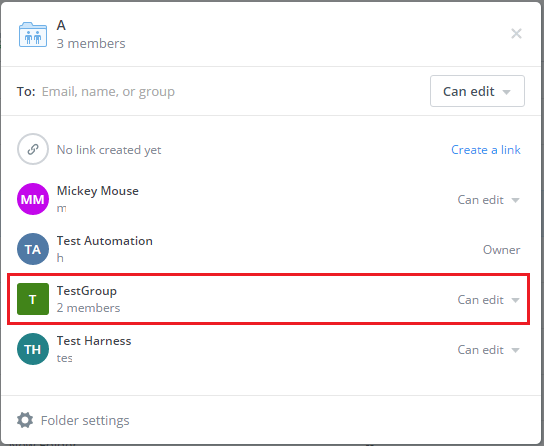
As we can see in the screenshot above, "TestGroup" is the group. When we would migrate this as-is (with no mapping) into OneDrive for Business a SharePoint group will be created with the same name "TestGroup".
If you would like to translate this into an existing Azure AD Group, we first need to locate the "Account" name of this Azure AD group. You can find the "Account" value by opening the User Information view for this group in either a SharePoint Online or OneDrive for Business site.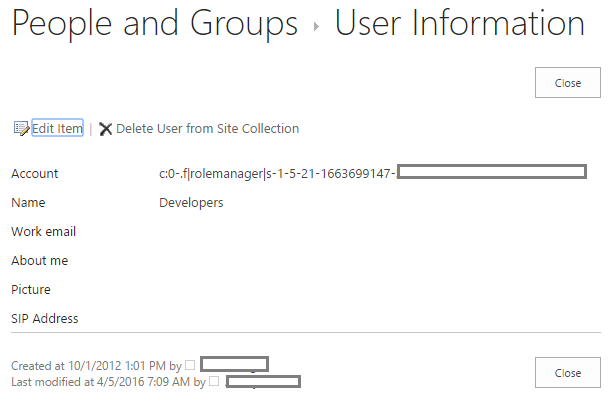
Copy the Account out of this screen for the group that you want to map into.
Make a new entry in your User Mapping file for the group.
As you can see, use the information from the Dropbox Business side on the leftmost column and use the information from your SharePoint side on the rightmost column. When you use this mapping file, your group should map from the Dropbox Business group to your existing AD group in OneDrive for Business.
Dropbox Business - Content Permissions and Mapping
Due to the differences between permissions in Dropbox Business versus those in OneDrive for Business, the following permission mapping is performed during the migration. If you wish to not include permissions, simply uncheck the "Copy Permissions" option during configuration.
|
Dropbox Business Shared Folder Permission Level |
OneDrive for Business Permission Level |
|
Viewer |
Read |
|
Editor |
Contribute |
|
Owner |
Full Control |
The "Copy Permissions" option migrates shared permissions assigned to Dropbox Business folders and files. By default files permissions is not enabled. Turning this option on will allow you to copy file level permissions from the source account to Office 365 Locations. In order to do this, you must enable the Copy Permissions checkbox, as well as enable the Copy Permissions options in the Copy Wizard.
|
|
NOTE: The Copy Permissions option will not work, even if it is enabled in the Profile Manager, if the Copy Permissions option is disabled in the copy wizard. |
In order to enable the Copy Permissions option, do the following:
1.Navigate to the Help tab within Essentials and select Profile Manager.
2.Within the Profile Manager, select the General Tab, and then check the Copy Permissions option.
3.Once you are done making your changes, exiting the wizard will prompt you to confirm you want to save your changes. Click yes.





